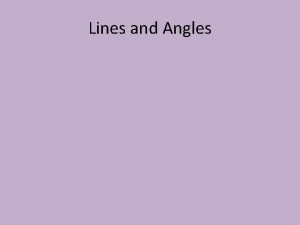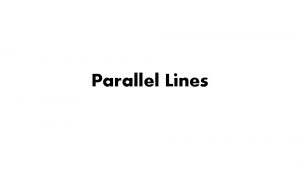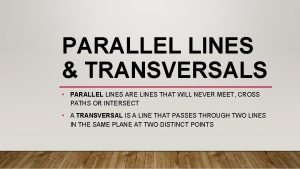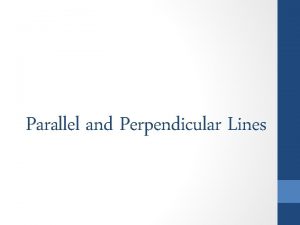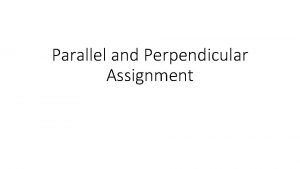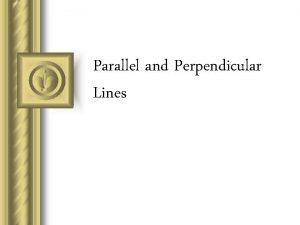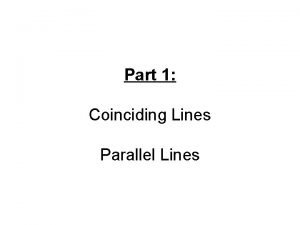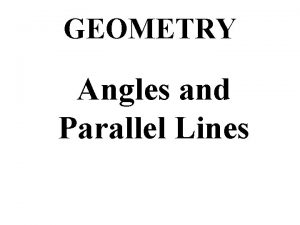Chapter 2 Parallel Lines Copyright Cengage Learning All














- Slides: 14

Chapter 2 Parallel Lines Copyright © Cengage Learning. All rights reserved.

2. 3 Proving Lines Parallel Copyright © Cengage Learning. All rights reserved.

Proving Lines Parallel Postulate 11 If two parallel lines are cut by a transversal, then the pairs of corresponding angles are congruent. Theorem 2. 1. 2 If two parallel lines are cut by a transversal, then the pairs of alternate interior angles are congruent. Theorem 2. 1. 3 If two parallel lines are cut by a transversal, then the pairs of alternate exterior angles are congruent. 3

Proving Lines Parallel Theorem 2. 1. 4 If two parallel lines are cut by a transversal, then the pairs of interior angles on the same side of the transversal are supplementary. Theorem 2. 1. 5 If two parallel lines are cut by a transversal, then the pairs of exterior angles on the same side of the transversal are supplementary. 4

Proving Lines Parallel Theorem 2. 3. 1 If two lines are cut by a transversal so that two corresponding angles are congruent, then these lines are parallel. Given: ℓ and m cut by transversal t 1 2 (See Figure 2. 16) Prove: ℓ || m Figure 2. 16 5

Proving Lines Parallel Theorem 2. 3. 2 If two lines are cut by a transversal so that two alternate interior angles are congruent, then these lines are parallel. Given: Lines ℓ and m and transversal t 2 3 (See Figure 2. 17) Prove: ℓ || m Figure 2. 17 6

Proving Lines Parallel Theorem 2. 3. 3 If two lines are cut by a transversal so that two alternate exterior angles are congruent, then these lines are parallel. In a more complex drawing, it may be difficult to decide which lines are parallel because of congruent angles. Consider Figure 2. 18 7

Proving Lines Parallel Suppose that 1 3. Which lines must be parallel? The resulting confusion (it appears that a may be parallel to b and c may be parallel to d) can be overcome by asking, “Which lines help form 1 and 3? ” In this case, 1 and 3 are formed by lines a and b with c as the transversal. Thus, a || b. 8

Example 1 In Figure 2. 18, which lines must be parallel if 3 8? Figure 2. 18 Solution: 3 and 8 are the alternate exterior angles formed when lines c and d are cut by transversal b. Thus, c || d. 9

Proving Lines Parallel Theorem 2. 3. 4 If two lines are cut by a transversal so that two interior angles on the same side of the transversal are supplementary, then these lines are parallel. Theorem 2. 3. 5 If two lines are cut by a transversal so that two exterior angles on the same side of the transversal are supplementary, then the lines are parallel. 10

Proving Lines Parallel Theorem 2. 3. 6 If two lines are each parallel to a third line, then these lines are parallel to each other. Theorem 2. 3. 7 If two coplanar lines are each perpendicular to a third line, then these lines are parallel to each other. 11

Proving Lines Parallel Construction 7 To construct the line parallel to a given line from a point not on that line. Given: and point P not on , as in Figure 2. 23(a) Figure 2. 23 (a) 12

Proving Lines Parallel Construct: The line through point P parallel to Construction: Figure 2. 23(b): Draw a line (to become a transversal) through point P and some point on. For convenience, we choose point A and draw. Figure 2. 23(b) 13

Proving Lines Parallel Figure 2. 23(c): Using P as the vertex, construct the angle that corresponds to PAB so that this angle is congruent to PAB. It may be necessary to extend upward to accomplish this. is the desired line parallel to. Figure 2. 23(c) 14
 Cengage chapter 7
Cengage chapter 7 Name all the rays
Name all the rays Chapter 13 medical math assignment sheet cengage learning
Chapter 13 medical math assignment sheet cengage learning Chapter 7:10 respiratory system
Chapter 7:10 respiratory system What are the two focal points of a fingerprint
What are the two focal points of a fingerprint Vertical angles
Vertical angles Chapter 6:2 interpreting word parts
Chapter 6:2 interpreting word parts Cengage chapter 5
Cengage chapter 5 Cengage learning heart diagram
Cengage learning heart diagram South-western cengage learning
South-western cengage learning 2009 delmar cengage learning
2009 delmar cengage learning Cengage learning heart diagram
Cengage learning heart diagram Clinical conditions chapter 1 medical terminology
Clinical conditions chapter 1 medical terminology Cengage learning australia
Cengage learning australia Graphing tpr
Graphing tpr





